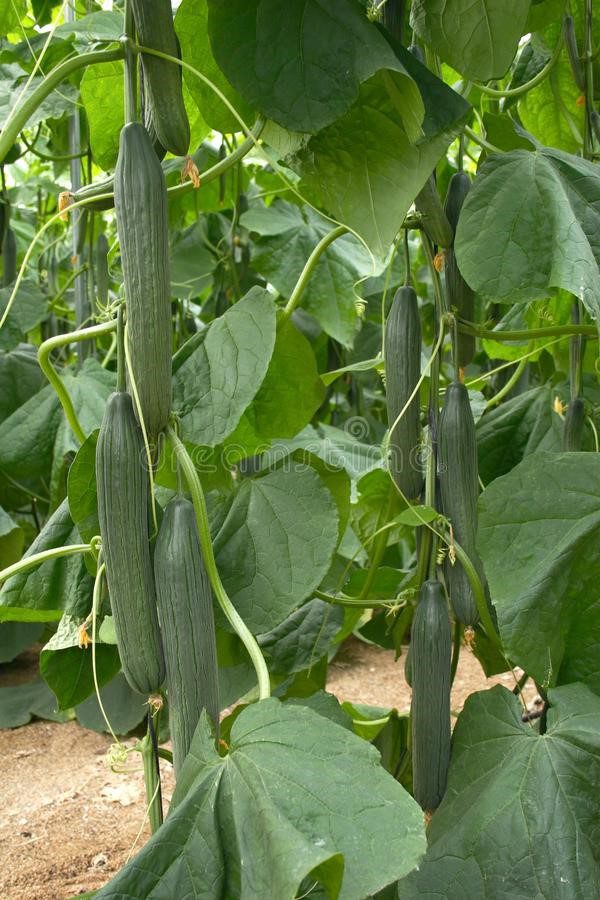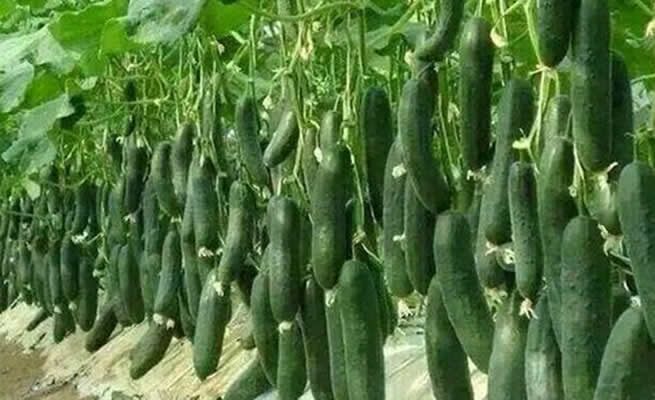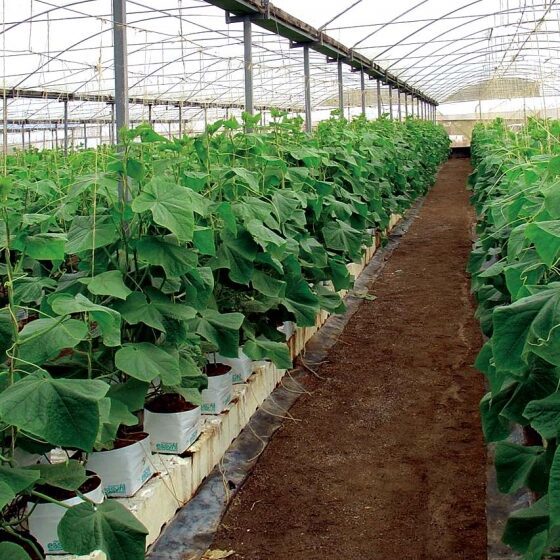Cucumber producers, like most other fresh vegetable and salad producers are very aware of current production limitations such high input costs, electricity outages, uneven market responses and a host of other subjects. It is therefore of high importance that the cucumber producer arm himself continuously with production technologies to increase yield per square metre.
Beginning with the soil
Cucumber plants prefer light textured soils that are well drained, have high organic matter and have a pH of 6 – 6.8. Cucumbers are adapted to a wide-range of soils, but will produce early in sandy soils, yet are fairly tolerant to acid soils (down to pH 5.5).
Greenhouse produced cucumber plants generally grow quite well in a wide range of soil pH (5.5-7.5), but a pH of 6.0-6.5 for mineral soils and a pH of 5.0-5.5 for organic soils are generally accepted as optimum. If the pH is too low, the producer should add ground calcitic limestone, or an equal amount of dolomitic limestone when the magnesium level in the soil is low, to raise it to a desirable level.
Usually the pH in most greenhouse mineral soils is above the optimum pH range (6.0-6.5). A simple, though temporary, solution to a high pH problem is to add peat, without neutralizing its acidity with limestone. Peat also helps to maintain a good soil structure, but it must be added yearly to make up for loss through decomposition.
The plant
The cucumber responds like a semitropical plant. It grows best under conditions of high temperature, humidity, and light intensity and with an uninterrupted supply of water and nutrients. Under favourable and stable environmental and nutritional conditions and when pests are under control, the plants grow rapidly and produce heavily. The main stem, laterals, and tendrils grow fast. They need frequent pruning to a single stem and training along vertical wires to maintain an optimal canopy that intercepts maximum light and allows sufficient air movement.
Specialists have it that, under optimal conditions, more fruit may initially develop from the axil of 4 each leaf than can later be supported to full size, thus fruit may need thinning. Those plants that are allowed to bear too much fruit will become exhausted, abort its fruit, and fluctuate widely in productivity over time.
Excessive plant vigour is indicated by rapid growth, thick and brittle stems, large leaves, long tendrils, deep green foliage, profusion of fruit, and large, deep yellow flowers. On the other hand, cucumbers are very sensitive to unfavourable conditions, and the slightest stress affects their growth and productivity.

Temperature
The main environmental component influencing vegetative growth, flower initiation, fruit growth, and fruit quality is air temperature. The growth rate of a cucumber crop depends on the average 24hour temperature. The higher the average air temperature is, the faster growth will be experienced. Also; a greater variation in day night air temperature creates a taller plant and smaller the leaf size.
Although maximum growth occurs at a day and night temperature of about 28°C, maximum fruit production is achieved with a night temperature of 19-20°C and a day temperature of 20-22°C. These recommended temperatures are designed after much research for sustained, high fruit productivity combined with moderate crop growth throughout the growing season.
During warm weather (i.e., summer and early autumn), reduce air temperature settings, especially during the night, by up to 2°C to encourage vegetative growth when it is retarded by the heavy fruit load. This regime saves energy because a 24hour average can be ensured by the prevailing high temperatures and favourable light conditions.
Soil temperature
To ensure satisfactory stand establishment, soil temperatures should not come below 15°C. The higher the soil temperature, the more rapidly seedlings emerge and the less vulnerable they are to insects and damping-off diseases.
It is found that at 15°C, 9 to 16 days are required for seedlings to emerge. At 21°C, only 5 to 6 days are required. Even after emergence, cucumbers remain sensitive to cold temperatures. In cold areas, seeds should always be planted late enough to avoid frosts. Exposure to cool conditions will slow growth even if temperatures remain above freezing.
Slow-growing seedlings are vulnerable to Flea beetles or Chrysomelidae (whose chewing significantly reduces leaf area of young plants). Too high temperatures during flowering decrease pollen viability. Be aware; a cool and cloudy growing season may cause bitter fruit!
Light sensitivity
Cucumber plant growth depends on light. Plant matter is produced by the process of photosynthesis, which takes place only when light is absorbed by the chlorophyll (green pigment) in the green parts of the plant, mostly the leaves. But do not underestimate the photosynthetic productivity of the cucumber fruit which, because of its size and colour, is a different story. In the process of photosynthesis, the energy of light fixes atmospheric carbon dioxide and water in the plant to produce carbohydrates such as sugars and starch.
It should be emphasized that, not only do poor light conditions limit photosynthetic productivity, but also limited carbohydrates produced during the day are largely expended by the respiring plant during the long nights. The low supply of carbohydrates available in the plant during the winter seriously limits productivity, as evidenced by the profusion of aborted fruit. A fully grown crop benefits from any increase in natural light intensity, provided that the plants have sufficient water, nutrients, and carbon dioxide and that air temperature is not too high.
Generally, the rate of photosynthesis relates to light intensity, but not proportionally. The importance of light becomes obvious in the winter, when it is in short supply. In the short, dull days of late autumn, winter, and early spring, the low daily levels of radiant energy result in low levels of carbohydrate production.
Relative Humidity
High relative humidity (RH) generally increases growth. Though, reasonable growth can be achieved at medium or even low relative humidity. Cucumber crops can adjust to and withstand relative humidity from low to very high but reacts very sensitively to drastic and frequent variation in relative humidity. Its sensitivity to such a variation is greatest when the crop is developed under conditions of high relative humidity.
Further disadvantages of cropping under conditions of high relative humidity include the increased risk of water condensing on the plants and the development of serious diseases. The resultant low transpiration rates are blamed for inadequate absorption and transport of certain nutrients, especially calcium to the leaf margins and fruit.
During low relative humidity, irrigation becomes critical, because large quantities of water must be added to the growth medium without constantly flooding the roots and depriving them of oxygen.

Harvesting
Fresh-market cucumbers are ready for harvesting when they are about 6 to 10 inches long and 1.5 to 2.5 inches in diameter. The cucumber should be dark to medium green, without any signs of yellowing. On average, 58 to 65 days are required from seeding to maturity, depending on the cultivar and the growing conditions. Fresh-market cucumbers are harvested by hand.
Since the individual fruits do not develop and mature consistently, the timing of maturity is not uniform within a field. As a result, fresh-market cucumbers are normally picked between 6 to 8 times over a 3-week period. Depending on favourable circumstances, cucumbers can be harvested up to 12 to 15 times in a season.
The number of pickings depends on when the seeds are planted and the supply and demand situation in the market. Price is an important factor in picking. Once prices for cucumbers fall below a certain level sadly, it becomes un-economical for growers to continue harvesting.
Advice to new greenhouse cucumber producers; find a seed supplier with the variety that is in demand, contact a reputable seedling grower – this saves you losses in seed while learning to grow seedlings. Your seeds man will give the best advice on his product – from planting to harvesting. Train, or get your greenhouse assistants well-trained in cucumber production from planting to harvesting – it will pay dividends. S. Robinson, MU

